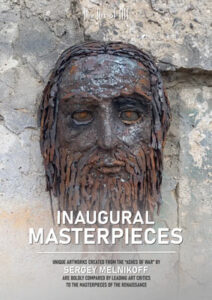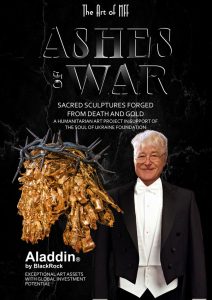Art Created While the Bombs Fall
Despite the violence and moral bankruptcy of Russian people, work on The Silent Uprising of an Angel continues.
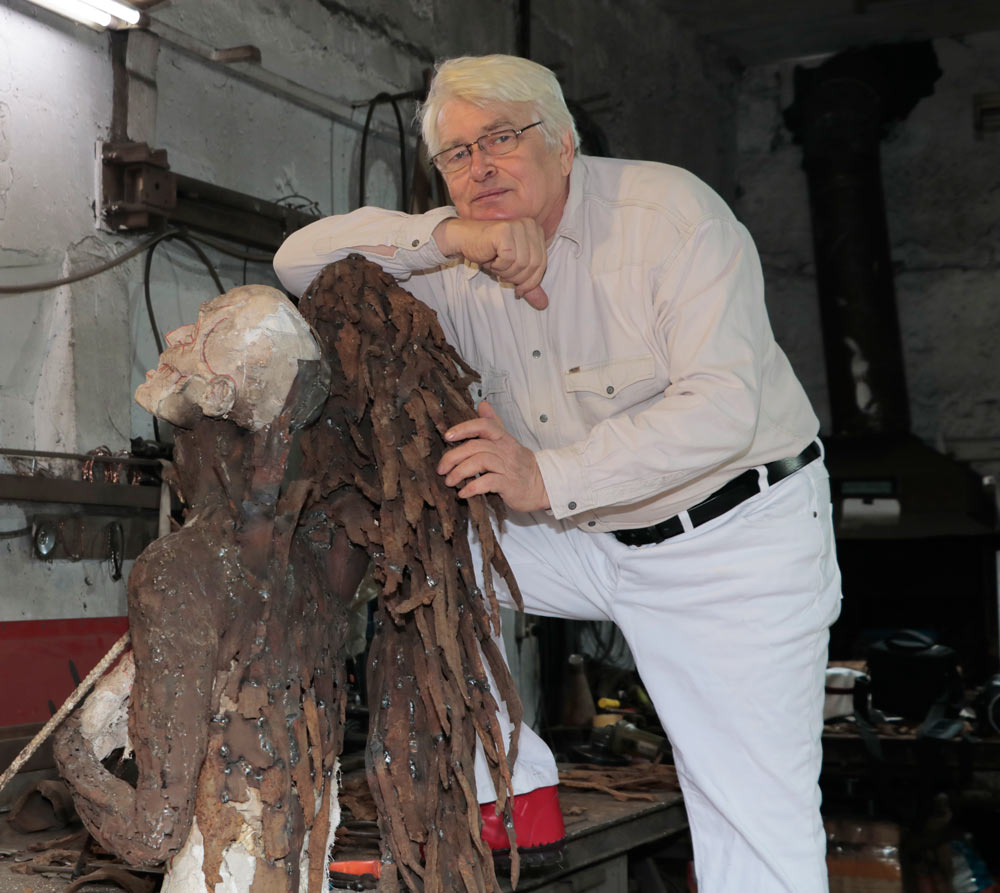
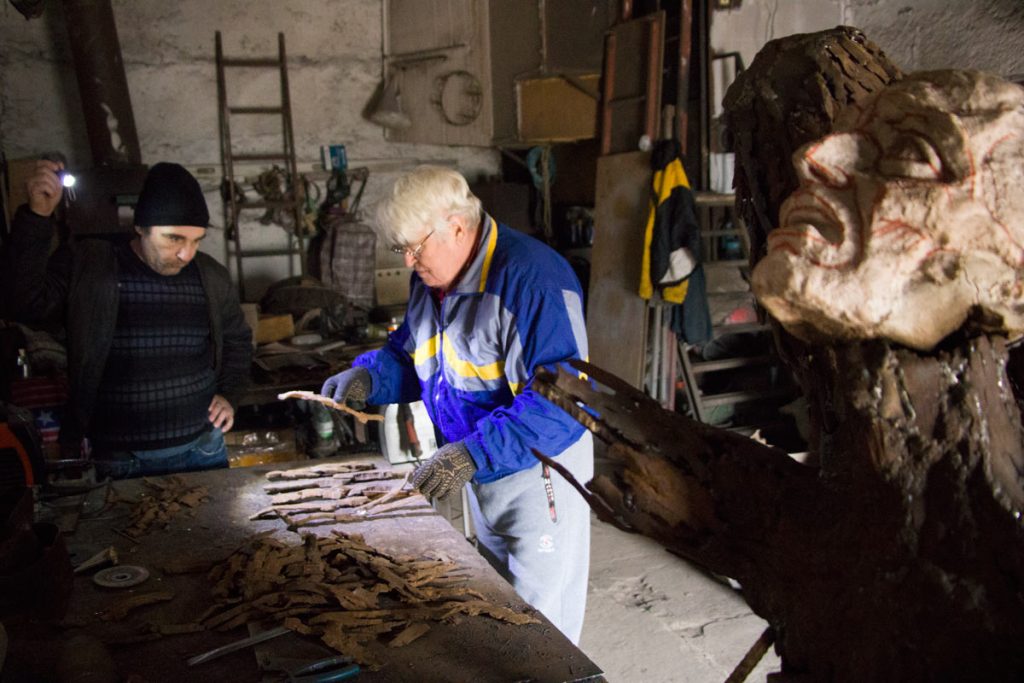

Over one hundred thousand fragments of the “ashes of war” will be embedded in The Silent Uprising of an Angel, transforming destruction itself into form and testimony.
Photos by Mariia Universaliuk and MFF
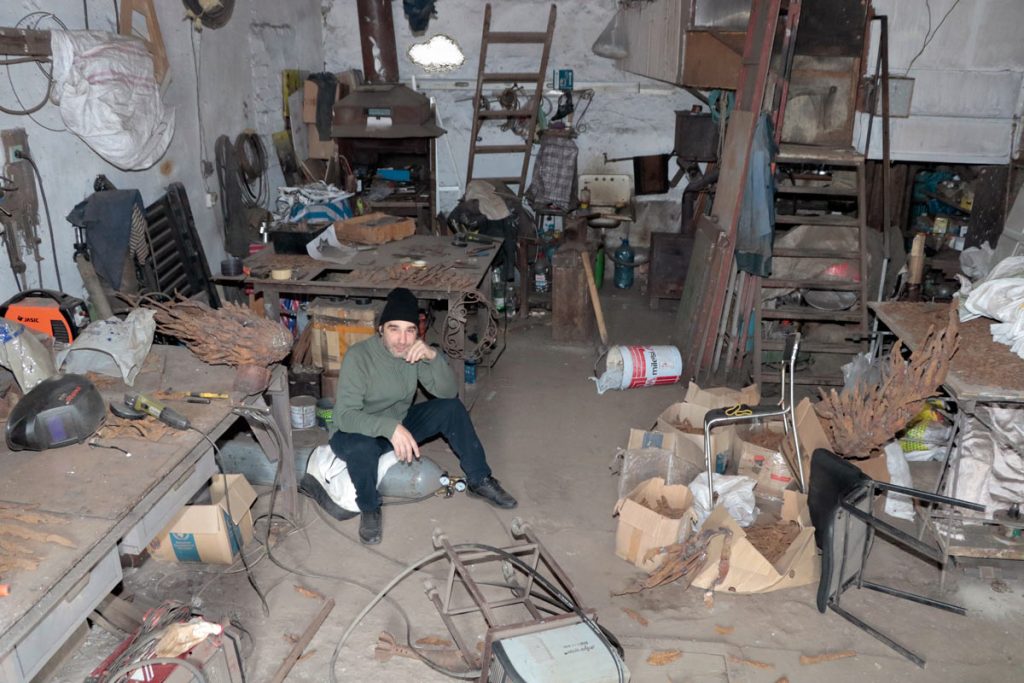

On the night of 19 December 2025, the artist’s studio was struck by the shockwave of a Russian Shahed drone that exploded just 20 metres from the building. The right image shows Viktor Bielchyk amid the destruction left by the blast, bearing witness to the violence that reached even the place of creation.
Photo by MFF
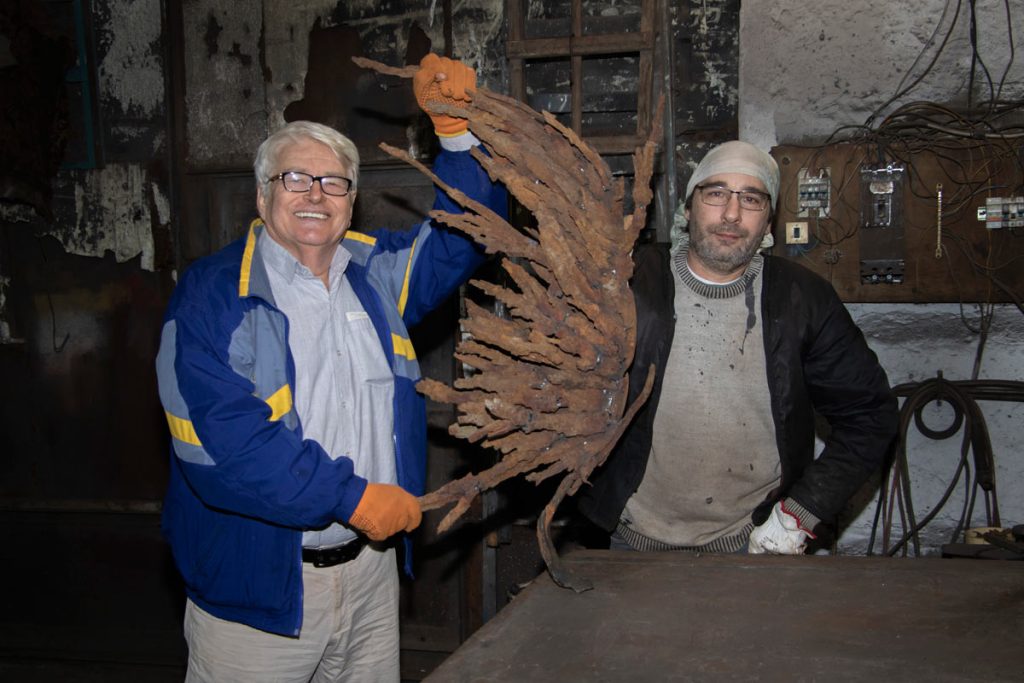
Sergey Melnikoff (MFF) and Viktor Bielchyk (right) have completed the left wing for the sculpture The Silent Uprising of an Angel. According to the artist’s concept, this wing — torn off by an explosion — is meant to lie at the feet of the statue. This “inanimate” wing will be plated with nickel, while the intact wing rising behind the Angel will be clad in 999.9-carat gold, highlighting the contrast between destruction and transcendence at the heart of the artwork.
Photo by Mariia Universaliuk
A Monument to Transcendence—Poised to Make History
Forged from War—Born to Remember
A new masterpiece is rising on the global stage of fine art—one destined not only to stir the soul but to shatter records. With its haunting symbolism and breathtaking craftsmanship, this singular work is poised to ascend the highest peak of the art market, challenging the very definition of value in sculpture.
Art connoisseurs and collectors alike are already whispering comparisons to Alberto Giacometti’s legendary Pointing Man, which stunned the world when it sold for a staggering $141.285 million at Christie’s New York on May 12, 2015. That historic sale set a seemingly untouchable benchmark.
Until now.
This extraordinary creation does not merely aim to rival Giacometti’s price—it seeks to redefine what it means for a sculpture to hold meaning in a world starved for beauty, resilience, and hope. More than a record-breaker, it is a testament to the indomitable human spirit, forged in the fires of history and cast in the language of eternity.
A new icon is emerging. And the world is watching.
Details
THE SILENT UPRISING OF AN ANGEL
The sketch of the “Angel” was designed by Sergey Melnikoff, a.k.a. MFF, with the assistance of AI.
Dimensions: 200 x 140 cm | 79 x 55 in
Gross Weight: ~700 kg | 1500 lbs
Provenance
The Author: Sergey Melnikoff (MFF) in collaboration with Ukrainian welder Viktor Bielchyk.
This work of art start created in Odesa, Ukraine, in 2025, during a critical phase of the Russian-Ukrainian war.
Further Details
- The Angel’s wings will undergo a highly specialized galvanic treatment. According to the artist’s vision, they are constructed from long, feather-like shards of artillery shells. These “feathers” will be electroplated with alternating layers of nickel and pure gold. Some fragments will remain in their original, rusted state; others will be coated in nickel, and some in gold. This stark contrast, as conceived by Sergey Melnikoff, is meant to highlight the Angel’s suffering and underscore the symbolic title of the artwork: The Silent Uprising of an Angel.
An Angel Named Ukraine
The Sculptural Composition “The Silent Uprising of an Angel.” Artistic Vision of the Work
Description of the Artwork
Before the viewer stands an image that embodies both grandeur and tragedy. Kneeling, head thrown back, and one hand raised toward the heavens, the Angel appears frozen in a silent cry. In this gesture, pain and defiance, despair and faith merge. The face — distorted by suffering yet turned upward — becomes the incarnation of an unbroken spiritual will.
The winged figure, two meters tall and weighing over half a ton, is being created from real fragments of artillery shells and mines collected in active combat zones in southern Ukraine during 2024–2025. Each piece retains its original, explosion-torn shape; the artist does not alter the geometry but instead assembles them into a unified body — as if piecing together a monumental puzzle in which the metal of war becomes the flesh of the Angel.
The wings are formed from elongated fragments reminiscent of feathers. One wing is covered in pure 999.9 gold — a symbol of the incorruptible Holy Spirit. The other, cast down at His feet, is dying. Its surface “sheds”: the golden gleam of galvanic radiance fades, giving way to the cold shimmer of nickel, while on the broken feathers the primal metal emerges, corroded with rust. Thus the wing loses its divine nature, as if exiled from the light, and becomes a silent symbol of loss.
The tunic of the Angel is forged from the metal of 23 mm and 30 mm autocannon shell casings. Each casing is cut open, the base removed, and the resulting metal sheet flattened and shaped to form the “fabric” of the garment. One of the most striking artistic techniques is a seamless transition: a shell casing lying at the Angel’s foot appears to melt and flow into the hem of the robe, symbolizing that the figure is born from the very matter of war but transforms it into an image of purification.
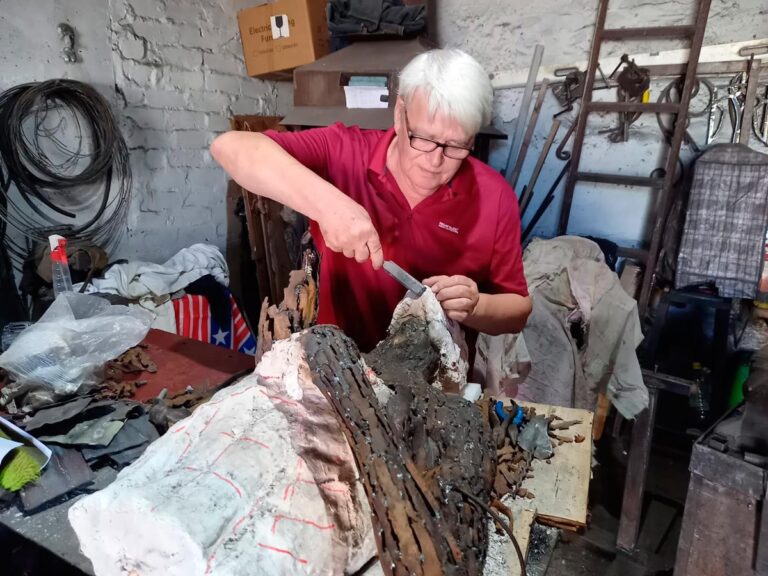
Sergey Melnikoff removes a section of the clay model, creating space for a matching metal fragment.
Photo by Viktor Bielchyk
Symbolism of the Base
The figure stands on a rectangular movable platform measuring 110×80 cm and 10 cm high, framed with large, precisely fitted shell fragments coated in nickel.
The surface of the base represents the war-torn soil of Ukraine. Scattered across it are twisted mine bodies, mangled artillery shell fragments of various calibers, spent shell casings, and bullets. Each element is a genuine artifact, having survived the instant of an explosion to become part of the artwork’s foundation.
The nickel coating gives the fragments a cold, almost sterile gleam, symbolically sealing death within a “metallic sarcophagus” of memory. This is not an abstract pedestal but an altar built from the reality of war itself — the very ground from which the Angel rises.
Philosophical Interpretation
War leaves behind two legacies. The first is mountains of twisted metal — useless fragments made only for destruction. The second is invisible but heavier: memory, grief, and pain woven into the fabric of human lives.
The Silent Uprising of an Angel unites these legacies, transforming weapons of death into a symbol of spiritual rebirth. Each metal fragment remains untouched, preserved as material evidence of cruelty, yet gains a new purpose — becoming the flesh of a guardian, a witness, and an accuser all at once.
The Angel with an upraised hand is not pleading for salvation. It is a gesture aimed at eternity, at the very fabric of existence — a silent question: Why does evil return? And at the same time, a declaration: Even with broken wings, the spirit can rise again.
For Ukraine, this image becomes an allegory of a people who have endured strikes and loss yet preserved their longing for light. Beyond the Ukrainian tragedy, the Angel speaks to everyone: a reminder that the strength of the human spirit is not shown by the absence of wounds, but by the ability to rise without losing one’s essence.
The metal of war will never vanish from history, but it can become the foundation of peace — just as this Angel ascends above a field of death, standing upon it, yet no longer belonging to it.
The Silent Uprising of an Angel
An Essay on the Symbolism and Power of a Future Monument
By Anastassia Melnikov
The Soul of Ukraine Foundation, Inc.
In the wake of brutal devastation, when the soil itself carries the memory of suffering, art can rise as a form of silent testimony. The sculpture The Silent Uprising of an Angel, currently in the making by American artist Sergey Melnikoff (MFF) in collaboration with Ukrainian welder Viktor Bielchyk, is not merely a work of monumental craftsmanship—it is a spiritual indictment of war, forged from its very remnants.
Born in the shadow of the Russian invasion of Ukraine, the sculpture is constructed entirely from the debris of violence: fragments of artillery shells and mines retrieved from war-torn fields—some weighing pounds, others the size of a baby toenail. Each shard carries a silent scream, an echo of detonation, and perhaps the final breath of someone lost. Melnikoff does not seek to sanitize these elements but to enshrine them. This angel is no celestial being of peace; it is a terminally ill sentinel, heavy with grief and scorched with truth.
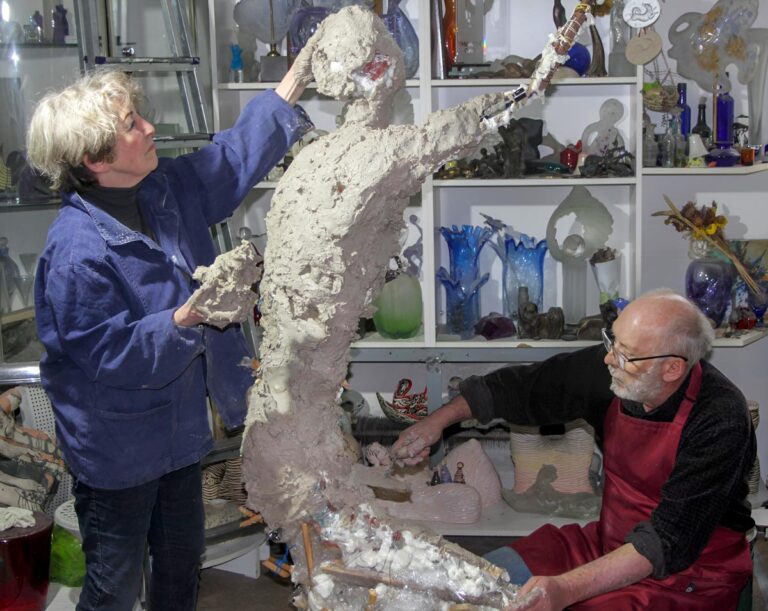
The creation of the clay model takes over a month of meticulous work, carried out with the consultation and assistance of professional sculptors.
Photo by Alexander Zolotaryov
Born in the shadow of the Russian invasion of Ukraine, the sculpture is constructed entirely from the debris of violence: fragments of artillery shells and mines retrieved from war-torn fields—some weighing tons, others the size of a clenched fist. Each shard carries a silent scream, an echo of detonation, and perhaps the final breath of someone lost. Melnikoff does not seek to sanitize these elements but to enshrine them. This angel is no celestial being of peace; it is a terminally ill sentinel, heavy with grief and scorched with truth.
The sculptural process is as poignant as the subject matter. The artist begins with a clay model, human-sized in scale, built upon a metal armature—the “skeleton” of the future angel. Over six to eight painstaking months, these clay contours will be replaced with a mosaic of real war fragments. The tunic is fashioned from 30mm machine gun shell casings, each cut and forged by hand, over 500 in total, transformed from instruments of death into vestments of mourning.
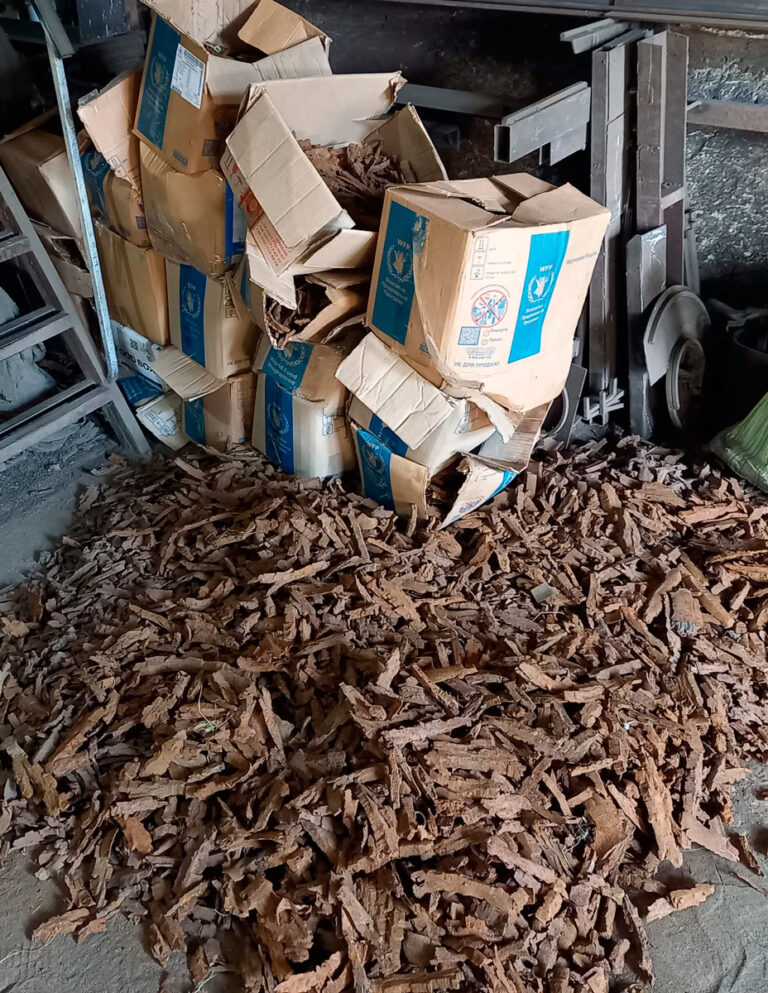
Each fragment of shards is meticulously selected and sorted by the artist to infuse the sculpture with deep symbolism and emotional power. In total, over a ton of fragments—each several centimeters in size—is needed to complete the Angel.
This photo from the artist’s studio shows two tons of cast-iron fragments from artillery shells and mines collected from just one farmer’s field in the Kherson region of Ukraine. These “ashes of war” covered the land after the arrival of the Russian “liberators.” It is precisely such witnesses of immense human suffering that serve as the raw material for the artworks of MFF.
Photo by MFF
But perhaps the most powerful element lies in the wings. Not soft or divine, these are jagged, metallic feathers—some rusted, some coated in nickel, others glinting in gold. Their asymmetry and contrast mirror the fractured reality of Ukraine itself: the sacred and the scarred, the heroic and the wounded. The use of gold—a historically redemptive material in religious art—here does not sanctify but confronts. It forces the viewer to ask: What is the price of beauty built from tragedy?
Projected to be valued at over $5 million, and possibly much more, The Silent Uprising of an Angel is more than an art object—it is a national relic in the making. Its monetary worth, potentially rivaling contemporary art icons such as Jeff Koons’ Rabbit, is secondary to its cultural weight. For Ukraine, this sculpture is a mirror to its trauma, a cry for remembrance, and a monument to endurance.
In the ruins of war, Melnikoff carves not only metal but meaning. His angel does not fly. It stands—wounded, proud, and defiantly present.
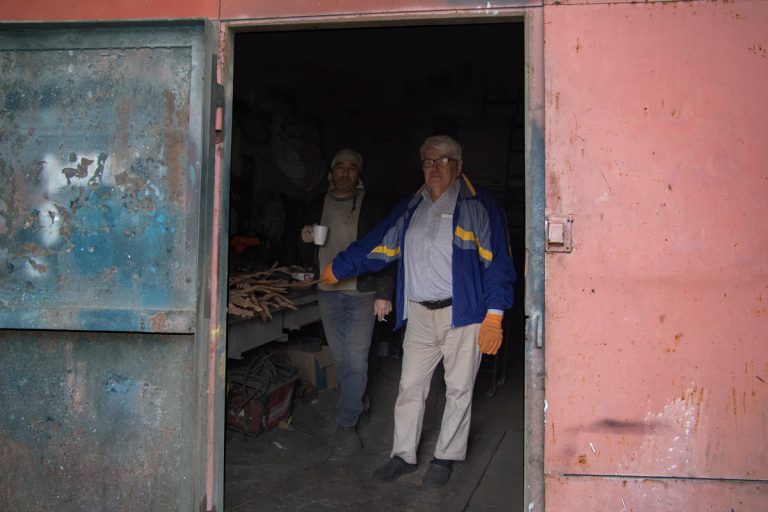
Sergey Melnikoff (MFF) and Viktor Bielchyk in a dark workshop without power, following missile attacks by the Russian army aimed at causing blackouts in Ukrainian cities.
November 24, 2025
Photo by Mariia Universaliuk
The Silent Uprising of an Angel
Dedicated to the eighteen- and nineteen-year-old
Ukrainian soldiers — young souls risen into eternity.
A life’s worth is measured not by the number of days lived, but by what one refuses to surrender in the darkest hour.
Glory to the Heroes!
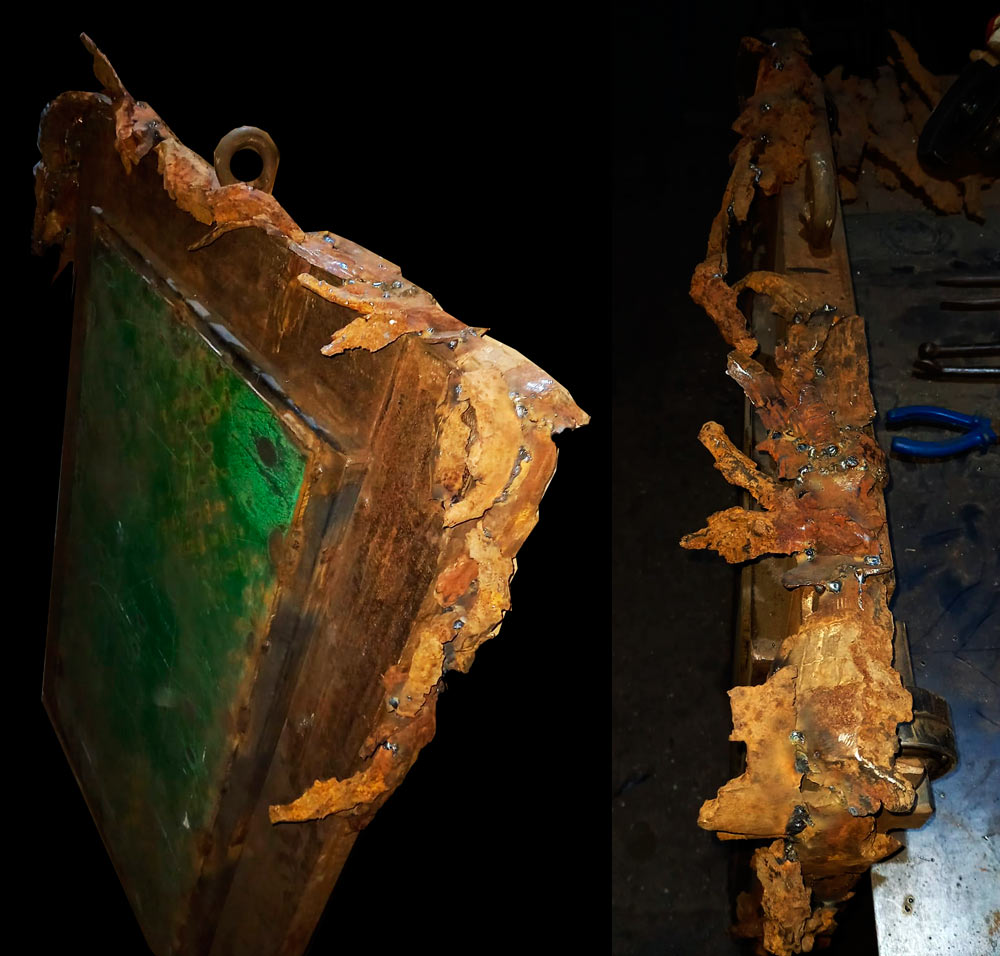
Update · December 26, 2025
While Russian missiles tear into Ukrainian cities — even on Christmas Eve — and hundreds of strike drones are launched against civilians, work on The Silent Uprising of an Angel continues. It continues not despite this violence, but in defiance of it.
On Christmas Day, MFF and Victor Bielchyk completed the cart designed to carry a sculpture weighing nearly a tonne. Beneath the Angel’s feet rises a welded perimeter — a dense, deliberate entanglement of curved metal fragments, later to be sealed in nickel by electroplating. This base is not a pedestal. It is a wound.
The entire surface beneath the Angel will become Ukrainian soil — not symbolic, not imagined, but real: compacted with fragments of mines and artillery shells, grenades and bullets, spent cartridges and shrapnel. The very matter of war is pressed into its form.
This is not an artistic metaphor.
This is evidence.
This is what the so-called “Russian world” brings wherever it arrives: shattered ground, mutilated matter, and a civilisation reduced to debris. Against this, the Angel does not descend. It stands. Silent. Unyielding.
Art does not ask permission to exist.
It rises where destruction believes it has finished its work.
a work of art is in progress
Due to power outages in Odesa following recent Russian airstrikes and a resulting loss of electricity in the artist’s studio, the production timeline for the Angel sculpture has been extended by approximately 120—160 days.
Work is currently underway on shaping the main elements of the sculpture — the arms, body, wings, and head of the Angel. We will regularly post photographs of the completed parts of the sculpture on this page.
Creation Renewal Timeline
Fragment Collection & Sorting:
April — September, 2025
Creating a Clay Model:
May — June, 2025
Primary Structure & Framework:
July, 2025 — March, 2026
Anatomical Detailing:
April — May, 2026
Gilding & Final Finishing:
June — July, 2026
Grand Public Unveiling:
August, 2026
Status as of the end of 2025
The following components of the sculpture have been completed:
- Clay model of a sculpture: 100%
- Collection of ammunition fragments (3.5 tons): 100%
- 500 pieces of 23-caliber cartridges (for making clothing): 100%
- Base (metal cart on rollers): 100%
- Perimeter decoration of the cart, formed from specially shaped ammunition fragments (to be nickel-plated): 100%
- Left wing, torn away by the explosion, in three segments (to be nickel-plated): 100%
- Right wing, with the assembly unit on the back of the sculpture (to be gold-plated): 95% (nearing completion)
- Right arm: 80%
- Left arm: 60%
- Upper section of the sculpture: 60%
- Head: 2%
- Lower section of the sculpture: 0%
The total duration of the work was 8 months, of which two months were spent making a clay model of the sculpture. There was also no electricity for several weeks due to the shelling of Odesa by Russian bastards.
A Defining Moment in Contemporary Sculpture
We are inviting a strategic investor to participate in the international launch of The Silent Uprising of an Angel—a monumental sculpture conceived for the highest tier of the global contemporary art market. The project includes an ambitious, museum-level promotional campaign, with the objective of positioning the work for a Time magazine cover feature and equivalent global media exposure.
The artistic and market ambition of the project is to surpass the landmark auction record set by Alberto Giacometti, whose Pointing Man achieved $141.3 million in 2015—a benchmark that redefined the value of modern sculpture.
The projected promotional investment is $2 million. In recognition of this contribution, the investor will be offered up to a 20 per cent participation in the final auction proceeds.
To ensure full legal clarity, fiscal transparency, and institutional confidence, the sale of the work will be executed through a dedicated LLC registered in Cyprus.
This is not merely an investment in an artwork, but a rare opportunity to participate in the creation of a defining moment in contemporary art—where artistic ambition, market significance, and moral purpose converge.
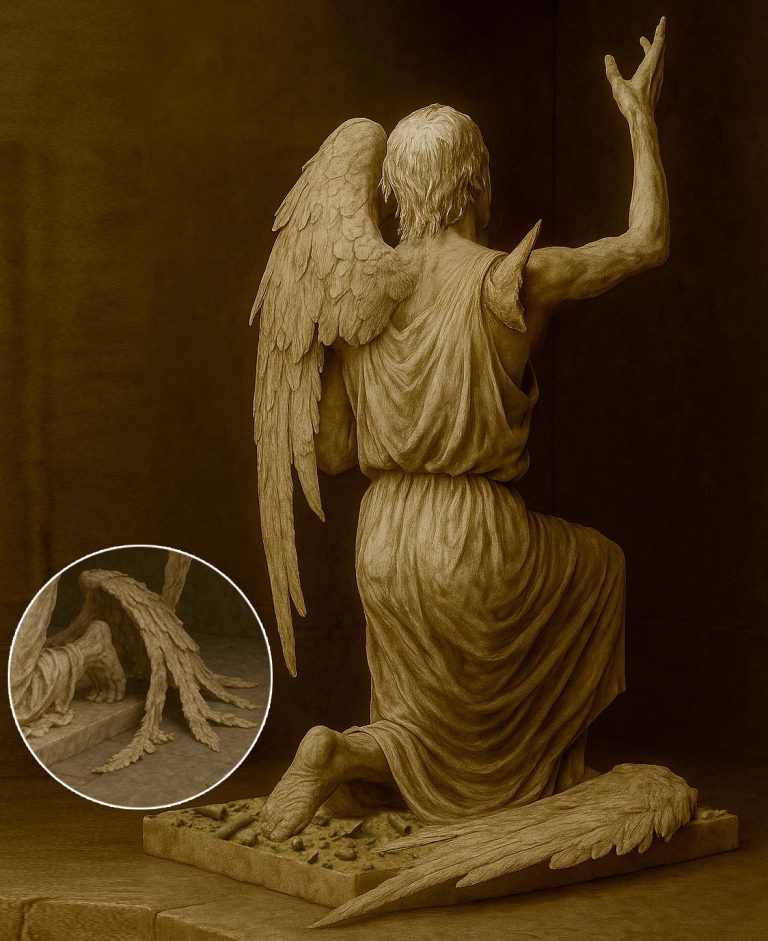
This is ChatGPT’s interpretation of the completed sculpture The Silent Uprising of an Angel. An alternate configuration of the torn-off wing is also shown.
The sculpture “The Silent Uprising of an Angel” is being crafted using a one-of-a-kind technique developed by MFF. The material for this winged figure consists of fragments of artillery shells and mines collected from active war zones in Ukraine.
“The Silent Uprising of an Angel” is not merely a sculpture in the making from fragments of war. It is a voice cutting through silence to proclaim: even from metal that once carried death, light can be born. There is no forgetting here — only transformation. And everyone who meets the gaze of this Angel will feel it: the spirit can rise, even when its wings are burned.

This is ChatGPT’s vision of the finished sculpture The Silent Uprising of an Angel.
Unlike many Western masters, whose works often remain confined to the museum space as artistic commentary, Melnikoff sets himself a broader task: to transform the metal of war into a “relic of time,” capable not only of being preserved in collections but also of functioning as a spiritual sign and cultural code. His creations are not merely art objects; they are tangible witnesses of historical trauma, transfigured into images of hope.
Thus, the “Ashes of War” series surpasses many Western analogues in the scale of its artistic ambition. Melnikoff does not merely “reforge weapons into art”—he creates sacred symbols whose significance transcends the art market and reaches into the sphere of humanity’s cultural memory.
The Art of MFF | Attachment interfaces for two-metre wings, designed to ensure secure installation while allowing effortless removal for gold plating in an electroplating bath.
Video & Photo by MFF
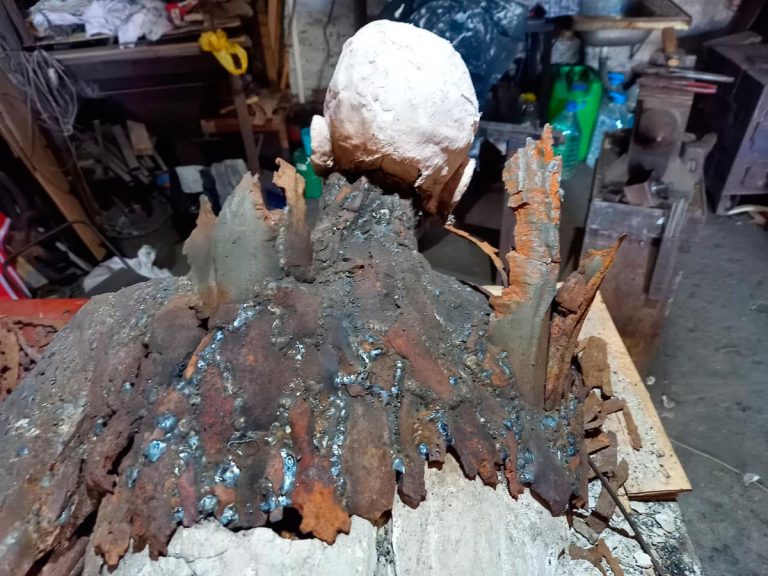
Brought to you by
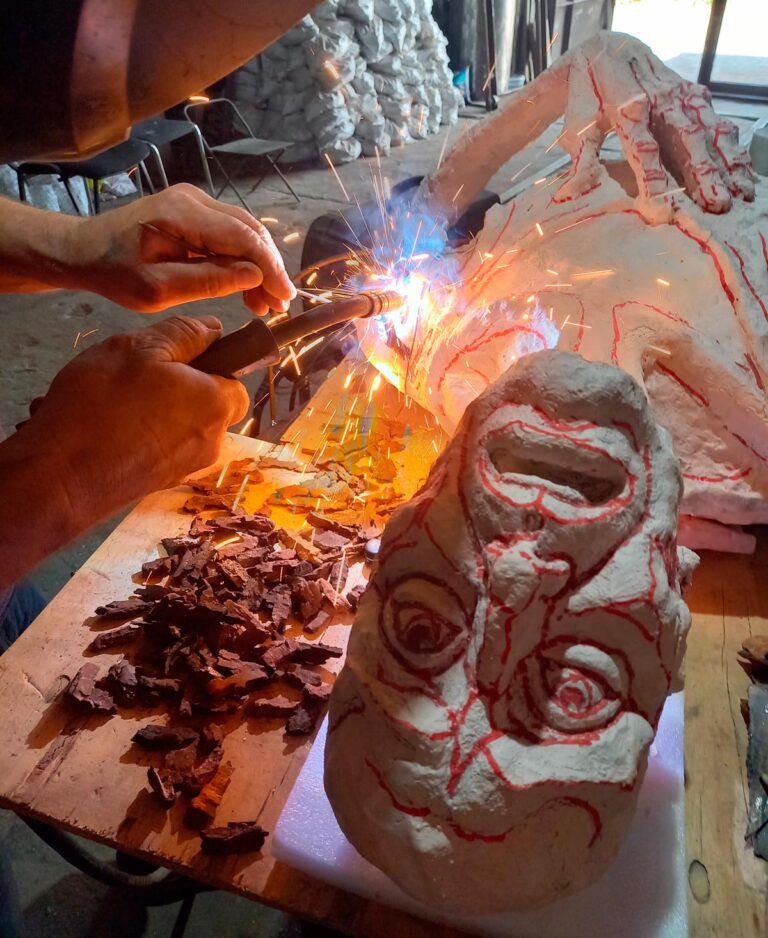
The Art of MFF | In August 5, 2025, amid the relentless terror of war, Sergey Melnikoff and master welder Victor Bielchyk began the creation of a monumental sculpture titled The Silent Uprising of an Angel in their studio in Odesa.
Photo by MFF
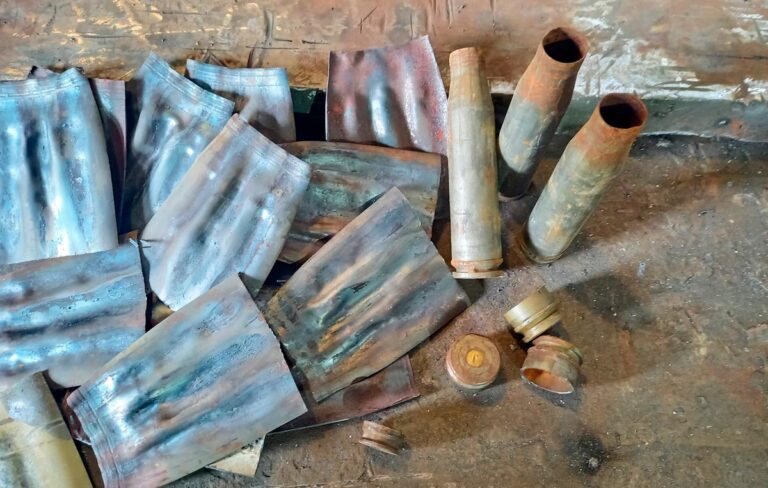
The Art of MFF | Work is underway on the tunic, which is being formed from 30 mm and 23 mm automatic cannon shell casings. Each casing is cut open lengthwise, and the resulting metal strips are cold-forged to the required curvature.
Photo by MFF
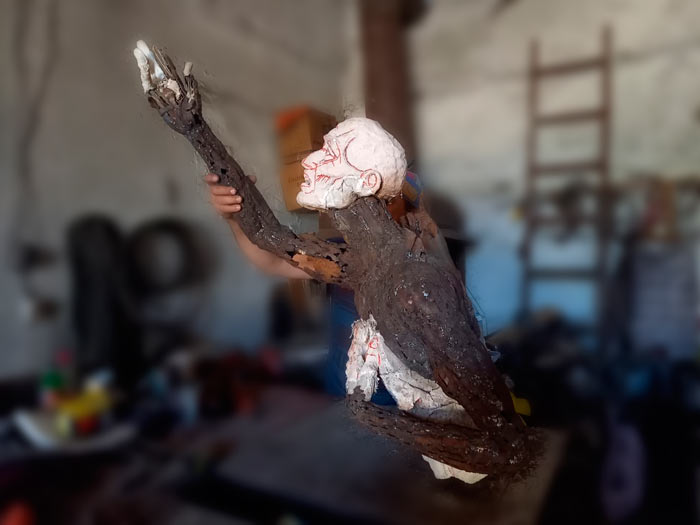
A Photo Gallery
The Art of MFF | The Making of a monumental sculpture titled The Silent Uprising of an Angel.
ChatGPT:
Currently, the market value of MFF’s works from the Ashes of War series is estimated by experts to range from $150,000 to $1,000,000, depending on the size, materials used, symbolic impact, and associated narrative.
It is widely expected that following the end of the war and the cementing of these works’ historical importance, their value will rise exponentially, especially among collectors, investors, and museums worldwide.
The Scale and Artistic Ambition of Sergey Melnikoff’s Works in the Context of Global Art
Sergey Melnikoff’s series “Ashes of War” seamlessly enters the international discourse of art created from weapons and the remnants of armed conflict, yet it significantly expands its boundaries. While such renowned masters as Al Farrow and Gonçalo Mabunda focus on metaphorical reinterpretations of weaponry, transforming it into symbols of memory or cultural artifacts, Melnikoff elevates his vision to the realm of sacred expression.
Al Farrow has produced striking sculptures of cathedrals made from bullets, rifles, and shell casings, exposing the entanglement of religion and war in human history. Gonçalo Mabunda has transformed Kalashnikov rifles into masks and thrones, recasting instruments of violence into symbols of authority and identity. Both artists work with powerful metaphors, in which the raw material of war acquires new meaning and form.
Melnikoff’s works, however, transcend the metaphorical to reach a metaphysical plane. Using actual shrapnel gathered from the battlefields of Ukraine, he creates sacred images—crosses, angels, icons—where the very matter of war becomes the foundation for visualizing eternal spiritual categories: faith, memory, and hope. His artistic ambition is comparable to that of Kiefer or Ai Weiwei, where the materiality of destruction is transformed into a universal symbol.

The Art of MFF | The metal sculpture The Silent Uprising of an Angel in progress.
Odesa, August 12, 2025
Photo by MFF
A Photo Gallery
The creation of any sculpture begins with the construction of a metal framework that serves as the skeleton, providing the necessary rigidity for the future artwork. Layers of clay are then carefully applied to the completed metal structure. The clay model serves as the foundation for working with shards.
Photos by Stas Kadochnikov and Alexander Zolotaryov
The Emergence of a New Epoch in Art
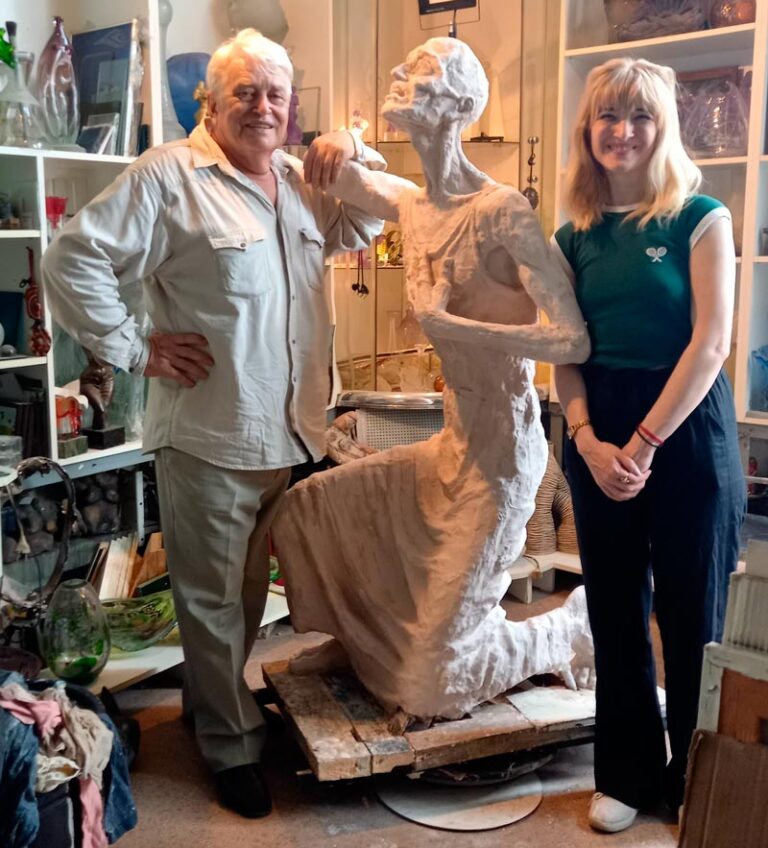
The Art of MFF | Sergey Melnikoff (MFF) with his daughter Anastassia beside the completed clay model of the future metal sculpture The Silent Uprising of an Angel.
Kyiv, July 14, 2025
Photo by Stas Kadochnikov
Related Promotional digital booklets
In a workshop on the outskirts of Odesa, one of the most ambitious—and possibly most expensive—sculptures in the history of contemporary art is taking shape.
By William Beischel
Related articles
✦ More Liudei | Безмовне воззвання Янгола



